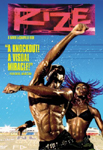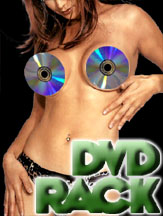
 BUY IT AT AMAZON: CLICK HERE!
BUY IT AT AMAZON: CLICK HERE!
STUDIO: Lion’s Gate
MSRP: $27.98
RATED: PG-13
RUNNING TIME: 84 Minutes
SPECIAL FEATURES:
• DVD introduction
• Filmmaking Insight with Director and DP
• New dancer interviews
• Tribeca Film Festival Q&A
• David LaChapelle Photo Gallery
• Dance moves by Rize dancers
• Extended dance sequences
• 7 deleted scenes
• Feature director commentary
• Trailers
The Pitch
"Psst! Hey, kid — you wanna buy a subculture?"
The Humans
Filmmaker David LaChapelle (no relation to Dave Chapelle) presents a host of dancing humans with names like Tommy the Clown, Tight Eyez, Miss Prissy, and Dragon.
The Nutshell
One day, my child, many years ago, a crazy ex-con took up the name Tommy the Clown and began performing hip-hop clown parties for deserving children. This clown not only could dance, he could dance and be funny at the same time, a fusion of entertainment elements that immediately became the inspiration for countless imitators. Other clown groups sprouted around Los Angeles; groups that were like gangs except that, instead of dealing drugs and being generally unpleasant, they put on shows for kids and engage in dance-offs in place of turf wars (very similar to the voguing houses of Paris is Burning, reviewed here).
An offshoot of the clowning, whose adherents adopted the title "krumping", though the word is about as malleable in meaning as their gymnastic bodies, sprang up to challenge the clowning, or, more likely, to expand on the artistic expression that seems to have accidentally evolved from the rubberized contortions of Tommy the Clown.

When Johnny Storm tried this move, he almost leveled New York City.
Rize tracks around the people involved in the clowning and krumping movements with a documentarian’s eye for the human interest, rather than the plot of events. It’s educational in the best possible way: destroying preconceptions and building respect in their places. It’s also kinetic, brilliant, and a boatload of fun to watch.
The Package
This is a damn good package. The aspect-ratio is fullscreen, but there are bonuses coming out the blowhole. There’s a DVD introduction featuring the cast and the director (always a nice touch, I think); there’s a small interview talking about the specifics of the filmmaking with LaChapelle and his cinematographer, Morgan Susser; there are additional interviews with a few of the dancers featured in Rize; there is a Q&A with the cast of the film at the Tribeca Film Festival; there is a semi-instructional section of dance moves performed by the dancers; there are extended dance sequences; there are seven deleted scenes of a worthy quality; there are trailers; there is a photo gallery; there is a director commentary (LaChapelle is almost as enthralling a speaker as he is a filmmaker); and, finally, there is fine Dolby 5.1 mix, in addition to the 2.0, which gives the awesome soundtrack (careening wildly from Dizzee Rascal to "Oh Happy Day") a beautiful presentation.
The Lowdown
The core sequence of Rize is a bit of brilliant editing in which clowners and krumpers are intercut with stock footage of African dance rituals. These two similar revolutions in dance, the clowning and the krumping, both find their roots, implicitly and explicitly, in the spiritual fervor of the barest form of religion, which is the expression of one’s own position in the wider world.

You and me and everyone we know.
This review ought not be about my expectations of the film, but I think it worth mentioning that this reviewer considers himself part of the target audience for this film, being a white male who has had minimal contact with this particular subculture. I admit to thinking the whole clowning craze was somewhat ridiculous. If you are of the same mindset, I encourage you to check this film out.
Rize takes advantage of the sympathy of its audience for the plight of underprivileged families, with an opening sequence that features the 1965 LA Civil Rights riots, the 1992 Rodney King Riots, and textual references to Martin Luther King, Jr. Instead of relying on that sympathy, however, the film takes a quick turn and, in a convincing display of independence, explains in detail why sympathy is unnecessary. There is a religion in
8.5 out of 10